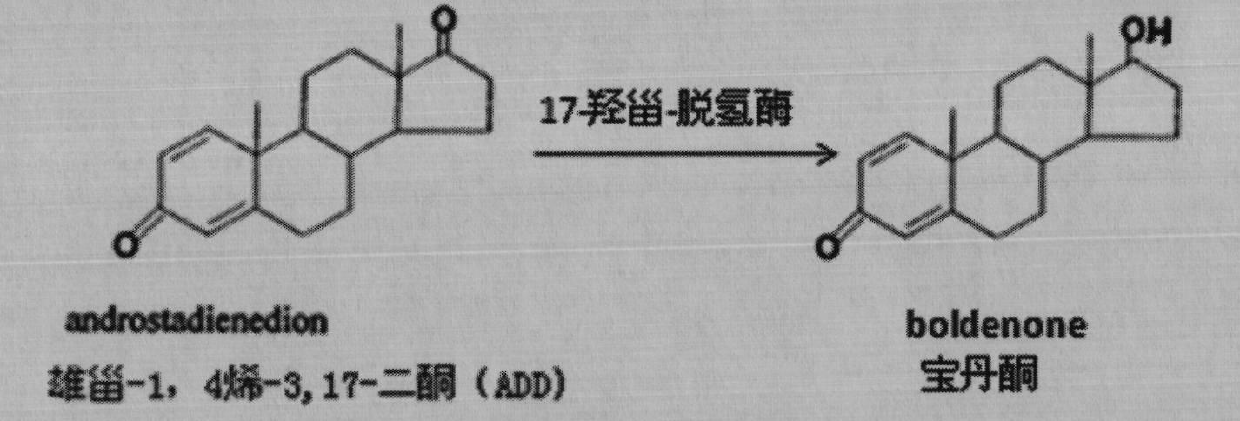3-ketosteroid -delta 1-dehydrogenase, engineering bacterium and application thereof
A technology of dehydrogenase and genetically engineered strains, which is applied to 3-sterone-Δ1-dehydrogenase and engineering bacteria and application fields to achieve the effects of improving utilization rate, mild reaction conditions, high economic and social benefits
- Summary
- Abstract
- Description
- Claims
- Application Information
AI Technical Summary
Problems solved by technology
Method used
Image
Examples
Embodiment 1
[0051] Example 1 , Acquisition of 3-sterone-Δ1-dehydrogenase gene from Metarhizium anisopliae
[0052] 1.1. Construction of the gene library of Metarhizium anisopliae
[0053] Refer to the method provided by the manufacturer, use the fungal genome extraction kit, extract the genome of Metarhizium anisopliae, and send it to Introvigen to prepare a gene library that can cover the genome of Metarhizium anisopliae 10 times.
[0054] 1.2. Design of merger primers
[0055] Through the Metarhizium anisopliae EST tag library, the reported fumigatus gene cluster of Aspergillus fumigatus (Silvia Lodeiro. Protostadienol Biosynthesis and Metabolism in the Pathogenic Fungus Aspergillus fumigatus. Organic Letters, 11, 2009) and the acquired gene fragments of Metarhizium anisopliae , design the degenerate primer pair of ksdD gene, the sequence of the degenerate primer pair of ksdD gene is shown as primer pair 2.
[0056] 1.3. The PCR method was used to catch the fumagic acid gene cluster...
Embodiment 2
[0072] Example 2 , Construction of Pichia pastoris engineering bacteria KM71-ksdD and GS115-ksdD
[0073] 2.1. Construction of Pichia pastoris (P. pastoris) expression vector pPIC3.5K-ksdD
[0074] According to the sequence characteristics of the multiple cloning site of the pPIC3.5K plasmid, construct upstream primers and downstream primers, as shown in primer pair 1, respectively. Using the primer pair, perform PCR, wherein the PCR reaction conditions and reaction system are as follows:
[0075] The 50ul PCR reaction system is as follows:
[0076] 2×PCR mix 25ul
[0077] Upstream primer 1ul
[0078] Downstream primer 1ul
[0079] Template 0.5ul
[0080] Water 22.5ul
[0081] The reaction procedure is as follows:
[0082] Pre-denaturation at 94°C for 5 minutes;
[0083] Denaturation 94°C 30sec
[0084] Annealing 50℃ 30sec 30 cycles;
[0085]Extend at 72°C for 10 minutes;
[0086] Keep warm at 4°C.
[0087] The PCR product was recovered with a PCR cycle pure kit ...
Embodiment 3
[0104] Example 3 , Pichia pastoris fermentation culture and protein expression detection
[0105] 3.1. Fermentation and cultivation of Pichia pastoris
[0106] Inoculate the Pichia pastoris KM71-ksdD1 and GS115-ksdD1 strains obtained in step 2.3 into 30ml BMGY liquid medium with 1% inoculum size, culture at 28°C and 200rpm for 40-48 hours, and then centrifuge under sterile conditions (5000rmp, 5mim, 4°C), transfer the precipitate into 30ml BMMY liquid medium, shake culture at 28°C, 200rpm, add 0.5% methanol every 24 hours to induce culture, cultivate for 7 days, and use an empty host without ksdD as a blank control .
[0107] 3.2 Determination of growth curve
[0108] Inoculate the Pichia yeast KM71-ksdD1 and GS115-ksdD1 strains obtained in step 2.3 into 30ml of BMGY liquid medium with 1% inoculum, culture at 28°C with shaking at 200rpm, take samples every 2 hours, and measure the OD 600nm . To draw a growth curve see Image 6 .
[0109] 3.3. Electrophoretic detection ...
PUM
 Login to View More
Login to View More Abstract
Description
Claims
Application Information
 Login to View More
Login to View More - R&D
- Intellectual Property
- Life Sciences
- Materials
- Tech Scout
- Unparalleled Data Quality
- Higher Quality Content
- 60% Fewer Hallucinations
Browse by: Latest US Patents, China's latest patents, Technical Efficacy Thesaurus, Application Domain, Technology Topic, Popular Technical Reports.
© 2025 PatSnap. All rights reserved.Legal|Privacy policy|Modern Slavery Act Transparency Statement|Sitemap|About US| Contact US: help@patsnap.com



